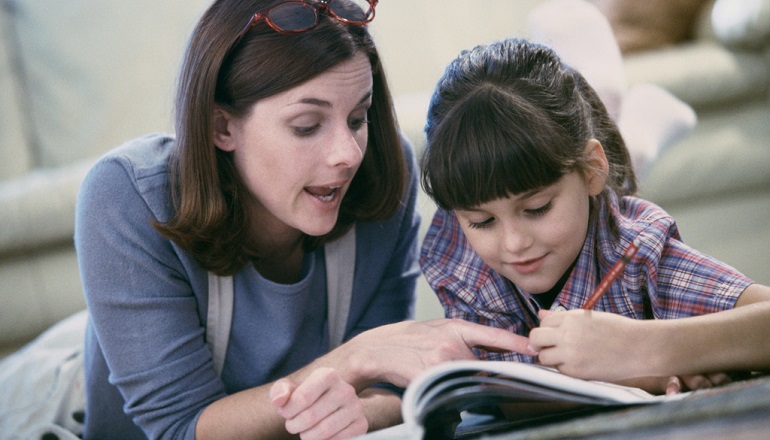Adoptive mom Lisa Anderson did not plan to homeschool. A busy working mother from Ferndale, Washington, she was too busy to take on the added responsibilities of teacher, principal, and recess monitor to her two children. But her 8-year-old daughter, Devi, was struggling in school, and when Devi began asking why she was stupid, Anderson was moved to take surprising action.
Disagreeing with the school’s diagnosis of learning problems, Lisa ultimately took both of her children out of the school system and joined a legion of parents across the country—including adoptive parents—who homeschool their kids. “I didn’t want to,” she says. “But I can’t let my kids get lost in the system.”
Homeschooling was once seen as the province of eccentrics, with skeptical onlookers wondering how one set of parents could provide the same range and depth of knowledge as a complex of teachers, administrators, and principals. Even though homeschooling was a normal part of American life until 100 years ago, parents have been sued and jailed for keeping children out of school. And many have been castigated by family and friends, accused of abuse and neglect. But is homeschooling really so bad? And more to the point: Is it maybe a good thing, especially considering some of the specific needs of adoptive families?
The 3 Rs at Home
Academic success is a primary reason that parents opt to homeschool. School budget cutbacks, growing class sizes, and troubled schools across the nation are motivating parents to educate their children at home. For just such reasons, single mom Lisa McClure of Tucson, Arizona, recently decided to homeschool her 8-year-old daughter, Lara, who was adopted from China as an infant. “I pulled my daughter out of public school in first grade because of the poor academic and social environment,” she says.
Any educator would agree that individual attention and committed, involved teachers are essential components of an effective learning environment. These are precisely the elements of good homeschooling. Many parents say they can see it in their eyes when their child understands a lesson. In conventional classrooms, teachers can’t wait for every child’s eyes to light up before moving on.
In addition, recent documented evidence supports the common sense of a home education. As more colleges, universities, and tests are asking students to identify themselves as homeschoolers, a body of statistics is emerging. (Some experts say the numbers are suspect, since many homeschoolers prefer not to identify themselves as such, for fear of prejudice.) On the SAT, the ACT, and the SAT2, homeschooled kids score consistently higher than the national average—except in math, in which ACT test scores have been a few points lower. In 2000, the top three finalists of the National Spelling Bee were homeschoolers. Also in 2000, Stanford University accepted 27 percent of its homeschooled applicants, almost twice the rate of its conventionally schooled applicants.
Freedom to Learn
A fundamental philosophy of many educators is that schools are most effective when children are encouraged to learn at their own pace and in their own style. Homeschoolers believe that this kind of flexibility and focus on the individual child is one of the great assets of a homeschooling curriculum.
Mary Ostyn, who homeschools her four biological children and two 5-year-old adopted sons, finds that flexibility benefits each of her children in their own way. “Our oldest had a real challenge staying focused in a busy, loud classroom,” she says. “Now, as a homeschooler, she holes up in her bedroom in utter quiet and has no trouble focusing.” Her second daughter, a math whiz, has moved ahead two grade levels in her math workbook. A physically active son has found success mixing activity with quiet time. And her 9-year-old son is reading high-school-level novels.
Holly Richardson, a Pleasant Grove, Utah, mom of 14 children, takes full advantage of homeschooling’s flexibility. “Our four oldest are involved in big, ambitious projects this year,” she says. “They are major projects that have a one- to five-year life span. The kids have had to research and come up with a plan and both short-term and long-term goals.”
Time to Bond
Perhaps surprisingly, the most common reason for homeschooling cited by adoptive parents is not academic achievement or freedom, but the opportunity for bonding. Ostyn is currently waiting to adopt two more children, one an 8-year-old girl from Ethiopia, whom she imagines will benefit tremendously from a homeschooling environment. “When this child comes home to us,” she says, “instead of immediately rushing off to school for hours a day, she will have the blessing of family time with Mom and Dad. Time to bond. Time to learn the language in a situation where no one will ridicule her or make her feel dumb.”
Richardson agrees. “We believe this is a great way to help in bonding and attachment,” she says. With children adopted as toddlers or older, Richardson has encountered a variety of attachment and behavioral difficulties. She finds that having her kids close has helped. “So many of my children have had months and sometimes years of no parenting,” she points out. At home, Richardson teaches social skills such as compromising, negotiating, and working together as a family unit. “You can learn academics any time in life,” she says. “Isn’t it critical to make sure their grounding is solid?”
Linda Harlow, who homeschooled her two high-school-age biological sons, is now doing the same with her three daughters, who were adopted from Russia. Along with its academic attributes, Harlow finds homeschooling helpful in dealing with the girls post-traumatic-stress disorder. “All of them have a real fear of failure,” she says. Her daughters often turn to outbursts of rage to express their frustration. “I’m able to deal with these things because I’m with them all the time,” Harlow says.
Perks for Older Kids
A growing number of homeschoolers feel that this education choice is well-suited to children adopted at an older age. Lisa Anderson believes that many schools are poorly equipped to deal with the social needs and language issues of these children. “Any parent adopting an older child should consider homeschooling for at least five years,” she says.
Lisa Porter, of Jacksonville, Florida, who homeschools her 10-year-old biological daughter, hopes to do the same with her 8- and 4-year-old children, recently adopted from India. “These kids are not typical ESL [English as a Second Language] kids,” she says. “They don’t fit into any category. If they’re at home, you can start with a kindergarten curriculum and go at their pace.”
A Creative Trend
Whatever the reasons, homeschoolers are growing in numbers. In 2012, the U.S. Department of Education estimated that 3.5% of students were being schooled at home, or approximately 1.8 million. Compare this to 20 years ago, when the estimated number was 50,000.
With these expanding figures—and help from the Internet—options for parents who school at home have increased. Today’s homeschooling styles are as diverse as parenting styles. They range from emulating the school day—sitting down at 9 a.m. with workbooks to cover the same subjects a traditional classroom would—to the unschooler’s way, based on a belief that the natural curiosity of a child will provide sufficient guidance. Between these extremes is every possible combination and variation.
The Social Question
Still, criticism of homeschooling is ongoing. “The thing we homeschoolers hear the most,” says one parent, “is ‘What about the socialization?'” But most insist their children have groups of friends, and active study groups.
“When I saw how highly socialized my three homeschooled nephews were, I decided that I would homeschool my kids,” says New York City mom Libby Moore, whose 8- and 5-year-old daughters were adopted from China. “The boys knew more about the world than most kids, and they went on to go to top universities, as well.” The Moore girls are out and about every day, playing soccer, taking dance, studying violin—all with diverse groups of children and adults.
“We belong to a great homeschool group in our area,” says Lisa Langdon, a mother of four who were adopted through the Washington State foster system. “We have spelling bees, science fairs, history fairs, and field trips.” “Besides,” she argues, “a traditional classroom is not necessarily the best way to become socialized. Homeschooling allows children to meet people of all ages, from all walks of life, because they are out and about as they learn.” “In a classroom,” she says, “children are forced to socialize only with children their own age.”
Satisfied Customers
There is no denying the effort involved in homeschooling. As one parent of three admits, “It can sometimes be stressful, and I would love to say, ‘Go to school.'” Moore asserts that you really have to like being with your kids. “Sometimes it’s hard being with them all the time—especially when they fight—but for me that’s rare,” she says. “All in all, it’s a lot easier than people think.”
For those who do take on the challenge, the results appear to speak for themselves. “My kids are confident and interact beautifully with people of all ages, they get lots of physical activity, and my 8-year-old is beyond her grade-level in reading and math,” says Moore. Langdon believes that after years of struggling to overcome the effects of unhappy foster homes and at least one failed adoption, homeschooling has made the difference for her children, and brought her family closer.
With these kinds of results—and for the skeptics, the hard facts of the test scores—homeschooling seems more and more like a viable option. Perhaps its becoming clear that what counts most are involved parents paying attention to their children. Or, as many parents will say, a well-grounded, well-raised child is more important than a good test score.
Of course, if these children do well on tests, too—so much the better.
Adapted from an article originally published in NY Family magazine.


